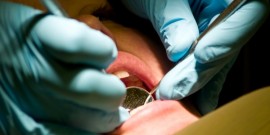
Startling article on oral cancer! Please read below and thank you for visiting us at Surrey Endodontic Centre!
The dentist’s office is the first line of defense for oral cancer diagnosis.
Approximately 60 percent of the population receives regular dental care1 and these visits are a unique opportunity to look for signs of cancer growth and discuss changes the patient has experienced in his or her mouth.
There are two ways dentists look for oral cancer: The first is a visual examination of the mouth and the second is through the use of adjunctive screening tools such asVelscope and ViziLite. Without vigilance, cancer diagnosis may be delayed which often translates to poorer outcomes and higher mortality rates. Oral cancer that is detected early has an 80 percent five-year survival rate compared to the overall five-year survival rate of 59 percent1.Sikka Software collects data from thousands of practices across the nation. Data is collected in accordance with privacy laws. This article will discuss trends in technology based screening under CDT D0431, adjunctive pre-diagnostic testing.Oral cancer incidence, signs and symptoms
According to the New York Times, one in 99 people will develop oral cancer in their lifetime. This translates to approximately 45,750 oral and pharyngeal cancers annually with 8,650 deaths2. Cancer is often associated with heavy drinking, use of tobacco products, UV exposure and more recently, HPV163. According to the Oral Cancer Foundation, HPV16-related oral cancers can be particularly challenging to identify as it tends to be in the back of the mouth and patients tend to be younger than the traditional oral cancer patients. An increase in smoking among women has possibility contributed to the move towards equalization in oral cancer gender ratios, although men are twice as likely to get oral cancer than women.
Oral cancer can be difficult to diagnose as there are generally few physical symptoms in the early stages. Visible physical changes may appear similar to other pathologies, like canker sores, increasing the challenge of diagnosing cancer early. A visual exam of high risk patients has found to reduce mortality 34 percent, however, 25 percent of cancer patients are not considered high risk2, opening up the debate for the place of technology-based screening tools in the clinic.
Continue reading original content HERE:


